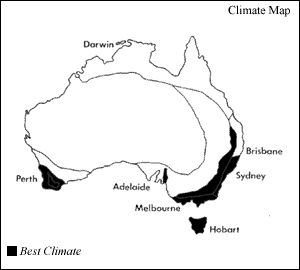One of the best things about winter in Australia is the fragrance of daphne in flower. Winter daphne (Daphne odora) originally comes from China. As well as the green-leafed variety with pink and white flowers, there is also one with a creamy yellow border to the leaf (‘Aureo-marginata’) and a pure white flowering form (‘Alba’).
Daphnes have a reputation for being very touchy plants. They often drop dead suddenly but if the right growing conditions are provided, they will last a long time and develop into large shrubs (see Best Climate map).
Buying the plant
One of the reasons daphne plants die is that they carry virus diseases which, although they do not kill the plant, can reduce its vigour and make it more susceptible to diseases such as root rots. Daphnes need extremely good drainage and are prone to root problems.
A healthy, virus-free daphne will have uniformly dark green, glossy leaves that grow horizontally from the stem. Look for a healthy green-leafed plant when you buy your daphne at the nursery. If the plant has a virus disease (see below), the foliage will be pock-marked or marbled with yellow and the new growth may be distorted.
Lighter green foliage and hanging leaves may indicate the early stages of root rot and the plant will almost certainly die.
Also avoid plants with pests such as scale. Signs of scale include brown lumps on the leaves or stems or sooty mould (a black soot-like covering) on the leaves.
Growing conditions
If you are going to grow daphne in the ground, it requires perfect drainage and a cool, sheltered spot. For good drainage grow the plant in a raised bed, that is a garden bed where the soil is built up by 20-30cm (8-12″). If this is not possible a pot is the next best alternative.
When potting up a daphne, put some plastic fly-wire over the drainage hole in the bottom of the pot. This is not for any horticultural reason, but to stop soil from leaching out of the drainage hole with each watering. Then add the potting mix, selecting a potting mix that meets the Australian Standard. It is a good idea to add a little peat moss to your mix to improve drainage and water-holding capacity of the mix.
Note: In some instances daphnes are grown in soil, dug up and sold in a pot. Any soil should be gently hosed away before it is repotted into potting mix.
Take care when potting, especially if you are handling a large plant. If you damage the roots in the repotting process, it is important to keep the repotted plant in a sheltered spot for several weeks to give it a chance to establish new roots. It will also need close attention in hot or windy weather until it is firmly established. Tip: For good growth on your daphne, add a sprinkle of gypsum to the potting mix.
Cost and availability
Daphne plants are available in most garden centres in the cooler parts of Australia, particularly during winter when the plants are in flower. They come in a range of sizes from small to advanced. Prices start at around $9.95 for a 15cm (6″) pot. As plants are slow growing, large advanced plants can be very expensive (around $30).
If you have a healthy daphne plant growing in your garden you may like to take some cuttings from the plant to give to friends or to keep in case your plant dies. The ideal time to take cuttings is during summer. Place cuttings in a pot of sand and peat propagation mix and keep in a cool, moist spot.



